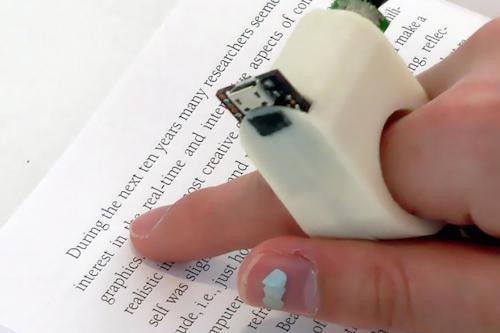This week on The Disability Tribune, we turn our attention to the FingerReader, from MIT Media Lab.
“The FingerReader is a wearable device that assists in reading printed text. It is a tool both for visually impaired people that require help with accessing printed text, as well as an aid for language translation. Wearers scan a text line with their finger and receive an audio feedback of the words and a haptic feedback of the layout: start and end of line, new line, and other cues. The FingerReader algorithm knows to detect and give feedback when the user veers away from the baseline of the text, and helps them maintain a straight scanning motion within the line.” (MIT Media Lab)
Recently, we were able to speak with Roy Shilkrot, a 4th year PhD student that works at the MIT Media Lab, to learn a bit more about the FingerReader.
Belo Cipriani: How did the FingerReader project come together?
Roy Shilkrot: The FingerReader came together after spending about 3 years developing a number of finger-worn prototypes, focusing on assisting people with visual impairments. Finally, we closed in on reading printed text, as we realized this application could make a big impact, and we actually have some interesting new approaches to suggest to traditional methods.
BC: What were some of the early challenges?
RS: The challenges are getting the device to work consistently and robustly for different people and text material. We are still looking for the right way to guide people effectively in reading text without being able to see it.
BC: How many blind people have helped with the testing of the FingerReader?
RS: We relied very much on the Visually Impaired and Blind User Group (VIBUG) that meets at MIT. They are a big group of people with different conditions of low vision, and multiple people from the group helped us shape it and test it.
BC: When do you think it may hit the market?
RS: The process to productize such a device is estimated at a one to two year period, during which we would focus on further development, manufacturing and preparing the distribution methods.
BC: Are you working on other accessibility projects?
RS: My work is in assistive technology, but not necessarily for people with any sensorial impairment, as I believe certain situations put all people in a position of lesser capacity. It happens every time we learn a new language or learn to use a new tool… So, my work spans the spectrum of assisting people with special needs to people with temporary or voluntary special needs.
To learn more about the FingerReader, visit the MIT Media Lab website and/or view this product Q&A.
Who is Belo Cipriani?
Belo Cipriani is the Writer-in-Residence at Holy Names University, a spokesperson for Guide Dogs for the Blind, the “Get to Work” columnist for SFGate.com, a contributing columnist for South Florida Gay News, and the author of Blind: A Memoir. You are invited to connect with him on Facebook, Twitter, Google+ and YouTube.

